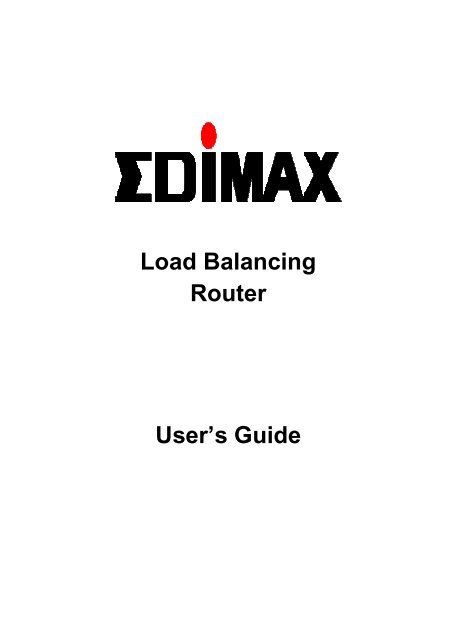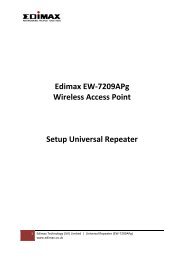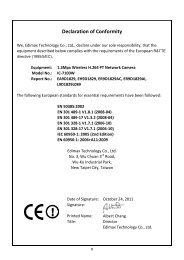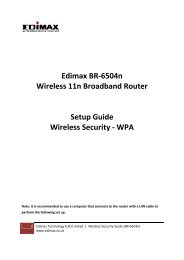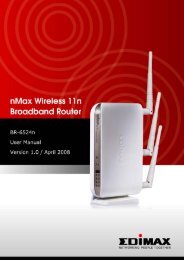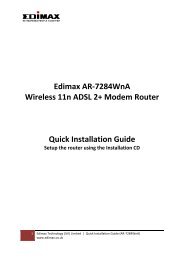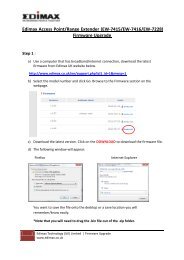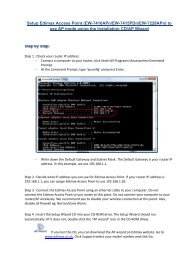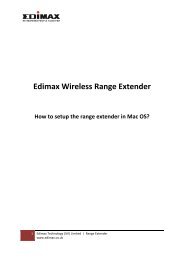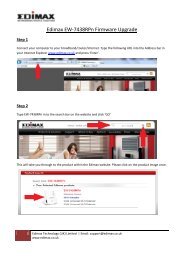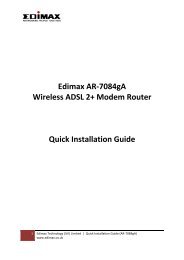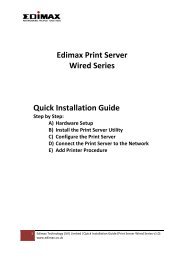Load Balancing Router User's Guide - Edimax
Load Balancing Router User's Guide - Edimax
Load Balancing Router User's Guide - Edimax
You also want an ePaper? Increase the reach of your titles
YUMPU automatically turns print PDFs into web optimized ePapers that Google loves.
TABLE OF CONTENTS1: INTRODUCTION ................................................................................................................................ 1Internet Features ............................................................................................................................ 1Other Features ................................................................................................................................ 3Package Contents .......................................................................................................................... 4Physical Details .............................................................................................................................. 42: BASIC SETUP.................................................................................................................................... 8Overview.......................................................................................................................................... 8Procedure ........................................................................................................................................ 83: ADVANCED PORT SETUP ............................................................................................................. 19Overview........................................................................................................................................ 19Port Options.................................................................................................................................. 19<strong>Load</strong> Balance ................................................................................................................................ 21Advanced PPPoE.......................................................................................................................... 23Advanced PPTP ............................................................................................................................ 244: ADVANCED SETUP ........................................................................................................................ 25Overview........................................................................................................................................ 25Host IP Setup ................................................................................................................................ 25Virtual Server ................................................................................................................................ 28Custom Virtual Server.................................................................................................................. 30Special Application ...................................................................................................................... 32Dynamic DNS ................................................................................................................................ 34Multi DMZ....................................................................................................................................... 36UPnP .............................................................................................................................................. 38NAT................................................................................................................................................. 39Advanced Features ...................................................................................................................... 415: SECURITY MANAGEMENT ……………………………………………………………………………..44Block URL...................................................................................................................................... 44Access Filter ................................................................................................................................. 46Session Limit ................................................................................................................................ 46System Filter Exception………………………………………………………………………….…… 496: QOS CONFIGURATION ………………………………………………………………………………….50Overview ………………………………………………………………………………………………...50QoS Setup ..................................................................................................................................... 50Policy Configuration .................................................................................................................... 517: MANAGEMENT ASSISTANT .......................................................................................................... 52Overview........................................................................................................................................ 52SNMP.............................................................................................................................................. 52Email Alert..................................................................................................................................... 53Syslog ............................................................................................................................................ 55Admin Password .......................................................................................................................... 57Upgrade Firmware........................................................................................................................ 588: ADVANCED LAN CONFIGURATION ………………………………………………………………...59Overview........................................................................................................................................ 59Existing DHCP Server ………………………………………………………………………………...59Routing .......................................................................................................................................... 59i
9: OPERATION AND STATUS ........................................................................................................... 63Operation....................................................................................................................................... 63System Status............................................................................................................................... 63WAN Status ................................................................................................................................... 66NAT Status .................................................................................................................................... 67APPENDIX A SPECIFICATIONS......................................................................................................... 69APPENDIX B WINDOWS TCP/IP SETUP........................................................................................... 70Overview........................................................................................................................................ 70TCP/IP Settings............................................................................................................................. 70APPENDIX C TROUBLESHOOTING .................................................................................................. 76Overview........................................................................................................................................ 76General Problems......................................................................................................................... 76Internet Access............................................................................................................................. 76Copyright ©2004. All Rights Reserved.Document Version: 1.4All trademarks and trade names are the properties of their respective owners.ii
1: IntroductionCongratulations on the purchase of your new <strong>Load</strong> Balancer. The <strong>Load</strong> Balancer provides SharedBroadband Internet Access for all LAN users.Figure 1-1: <strong>Load</strong> BalancerInternet Features• Shared Broadband Internet AccessAll LAN users can access the Internet through the <strong>Load</strong> Balancer, by sharing one (1) or two (2)Broadband modems and connections.• High-Performance Dual Modem SupportThe <strong>Load</strong> Balancer has two (2) WAN ports, allowing connection of two (2) Broadband modems.This gives twice the bandwidth of a single modem.Flexible configuration allows each port to use a different type of modem and connection method.Also, you can determine how the Internet traffic is shared between the 2 modems.• Supports all common Connection MethodsAll popular DSL and Cable Modems and connection methods are supported, including Fixed IP,Dynamic IP, PPPoE, and PPTP.• PPPoE Session ManagementMultiple PPPoE sessions are supported and you can choose to “map” sessions to individual PCsif desired.Page 1
• Multiple IP Address SupportIf your ISP allocates you multiple IP addresses, these are also supported and you can “map” IPaddresses to individual PCs if desired.• Special ApplicationsThis feature allows you to use some non-standard applications, where the port number used forthe response is different to the port number used by the sender.• Virtual ServersThis feature allows Internet users to access Internet servers on your LAN. For standard serverssuch as Web, FTP or E-Mail servers, only the IP address of the server PC is required. You canalso define you own Server types if required.• Multiple DMZA "DMZ" PC will receive incoming connection requests, which would otherwise be blocked. Foreach IP address allocated by your ISP, a separate "DMZ" PC can be specified. So if your ISP hasgiven you multiple IP addresses, you can have multiple “DMZ” PCs. Each “DMZ” PC hasunrestricted 2-way Internet access, providing the ability to run programs that are otherwiseincompatible with NAT routers like the <strong>Load</strong> Balancer.• Access FilterThe network Administrator can use the Access Filter to gain fine control over the Internet accessand applications available to LAN users. Five (5) user groups are available, and each group canhave different access rights.• Block URLUse this feature to block access to undesirable Web sites by LAN users. You can even havedifferent settings for different groups of PCs.• Session LimitWith Session Limit feature, if the numbers of new sessions for system exceed the maximum inthe sampling time, any new session in the system will be drop.• System Filter ExceptionWith firewall exception, the packets will not be processed by firewall or NAT module, but beprocessed directly by system protocol stack.Page 2
Other Features• 4-Port Switching HubThe <strong>Load</strong> Balancer incorporates a 4-port 10 /100BaseT switching hub, making it easy to create orextend your LAN.• DHCP Server SupportDynamic Host Configuration Protocol provides a dynamic IP address to PCs and other devicesupon request. The <strong>Load</strong> Balancer can act as a DHCP Server for devices on your local LAN.• Multi Segment LAN SupportLANs containing one or more segments are supported, via The <strong>Load</strong> Balancer's built-in staticrouting table.• ARP proxyThe ARP proxy feature allows you to assign an external (Internet) IP address to The <strong>Load</strong>Balancer's LAN port. This allows Servers on your LAN to have external (Internet) IP addresses.• Easy SetupUse your favorite WEB browser for configuration.• Remote ManagementThe <strong>Load</strong> Balancer can be managed from any PC on your LAN. And, if the Internet connectionexists, it can also (optionally) be configured via the Internet.• Password - protected ConfigurationOptional password protection is provided to prevent unauthorized users from modifying theconfiguration data and settings.• HTTP Firmware Upgrade and backupThe web management feature allows you to use HTTP upgrade new firmware and backupsystem configuration from local or even from remote site. As long as you enable “Remoteupgrade” and “Remote web-based setup” from Advanced feature web page.• Email AlertIt will send a warning email to the system administrator, if one of the WAN ports wasdisconnected when both WAN ports are enabled.• SyslogIt can generate real time system information on the web page or a particular machine. It is usefulto monitor the device.• QoS Configuration.This function will make some specified packets with higher priority for pass-through. Especiallyyou use real-time applications like Internet phone, video conference,. etc.• UPnPTo “Enable” UpnP (Universal Plug & Play), the load balancer will become one of the networkdevices. It is useful to discovery and control network devices, such as Internet gateway.Page 3
Package ContentsThe following items should be included:• The <strong>Load</strong> Balancer Unit• Power Adapter• Quick Installation <strong>Guide</strong>• CD-ROM containing the on-line manual.If any of the above items are damaged or missing, please contact your dealer immediately.Physical DetailsFront PanelOperation of the Front Panel LEDs is as follows:LANLINK/ACT10M/100MWANLINK/ACT10M/100MSystemPowerStatusON – Physical connection or data in/out.OFF – No physical connection.ON – The corresponding LAN port is using 100BaseT.OFF – 10BaseT connection on the corresponding LAN port or no connection.ON – Physical connection to the Broadband modem on WAN port 1/2 established.OFF – No physical connection on WAN port 1/2.ON – Physical connection using 100BaseT on WAN port 1/2 established.OFF – 10BaseT connection or no connection on WAN port 1/2.OFF – No power.ON – Normal OperationOFF – Normal operation.ON – Firmware not loaded or Hardware error.Blinking – Data in/outPage 4
Also, some Status and Error conditions are indicated by combinationsof LEDs, as shown belowLED ActionWAN1 LINK/ACT & 10M/100M LEDs flash alternatively.WAN1 LINK/ACT & 10M/100M LEDs flash concurrently.WAN1 LINK/ACT & 10M/100M LEDs solid OnWAN2 LINK/ACT & 10M/100M LEDs solid OnLAN1 LINK/ACT & 10M/100M LEDs solid OnConditionFirmware Download in progress.MAC address not assigned.SDRAM errorTimer/Interrupt errorLAN/WAN errorPage 5
Rear PanelDC 5VWAN 2Figure 1-2: Rear PanelConnect the supplied power adapter here.Connect the 2 nd Broadband Modem here, if available.Reset Button When pressed and released, The <strong>Load</strong> Balancer will reboot (restart) within 1second. It resets to default over 3 seconds.LAN PortsConnect the PCs to these ports. Both 10BaseT and 100BaseT connections canbe used simultaneously.Note:WAN 1Any port will automatically operate as an "Uplink" port if required. Just use anormal LAN cable to connect to a normal port on another hub.Connect the primary Broadband Modem here.Default SettingsWhen The <strong>Load</strong> Balancer has finished booting, all configuration settings will be set to the factorydefaults, including:• IP Address set to its default value of 192.168.1.1, with a Network Mask of 255.255.255.0• DHCP Server is enabled• User Name: admin• Password cleared (no password)TFTP DownloadThis setting should be used only if your <strong>Load</strong> Balancer is unusable, and you wish to restore it bydownloading new firmware. Follow this procedure:1. Power On The <strong>Load</strong> Balancer.2. Use the supplied Windows utility or a TFTP client program applies the new firmware. If using thesupplied Windows TFTP program, the screen will look like the following example.Page 6
Figure 1-3: Windows TFTP utility• Enter the name of the firmware upgrade file on your PC, or click the "Browse" button to locatethe file.• Enter the LAN IP address of The <strong>Load</strong> Balancer in the "Server IP" field.• Click "Download" to send the file to The <strong>Load</strong> Balancer.3. When downloading is finished. It should then work normally, using the default settings.Note:The supplied Windows TFTP utility also allows you to perform three (3) other operations:• Save the current configuration settings to your PC (use the "Upload" button).• Restore a previously-saved configuration file to The <strong>Load</strong> Balancer (use the "Download" button).• Set The <strong>Load</strong> Balancer to its default values (use the "Set to Default" button).Page 7
2: Basic SetupOverviewBasic Setup of your <strong>Load</strong> Balancer involves the following steps:1. Attach The <strong>Load</strong> Balancer to one (1) PC, and configure it for your LAN.2. Install your <strong>Load</strong> Balancer in your LAN, and connect the Broadband Modem or Modems.3. Configure your <strong>Load</strong> Balancer for Internet Access.4. Configure PCs on your LAN to use The <strong>Load</strong> Balancer.Requirements• One (1) or two (2) DSL or Cable modems, each with an Internet Access account with an ISP.• Network cables. Use standard 10/100BaseT network (UTP) cables with RJ45 connectors• TCP/IP network protocol must be installed on all PCs.Procedure1: Configuring The <strong>Load</strong> Balancer for your LAN1. Use a standard LAN cable to connect your PC to any Hub port on The <strong>Load</strong> Balancer.2. Connect the power adapter and power up The <strong>Load</strong> Balancer. Only use the power adapterprovided; using a different one may cause hardware damage.3. Start your PC. If your PC is already running, restart it. It will then obtain an IP address from The<strong>Load</strong> Balancer.4. Start your WEB browser.5. In the Address or Location box enter:HTTP://192.168.1.16. You will be prompted for the User Name and password, as shown below.Figure 2-1: Password Dialog7. Enter admin for the "User Name" and leave the "Password" blank.• The "User Name" is always adminPage 8
• You can and should set a password, using the following Admin Password screen.No Response ?• Is your PC using a Fixed IP address ?If so, you must configure your PC to use an IP address within the range 192.168.1.2 to192.168.1.254, with a Network Mask of 255.255.255.0. See Appendix B – WindowsTCP/IP Setup for details.• Check that The <strong>Load</strong> Balancer is properly installed, LAN connection is OK, and it ispowered ON.8. After the login, you will then see the Admin Password screen, as shown below.Assign a password by entering it in the "Password" and "Verify Fields.Figure 2-2: Home Screen (Admin Password)Page 9
9. Select LAN & DHCP from the menu. You will see a screen like the example below.Figure 2-3: LAN & DHCP10. Ensure these settings are suitable for your LAN:• The default settings are suitable for many situations.• See the following table for details of each setting.11. Save your data, then go to Step 2, Installing The <strong>Load</strong> Balancer in your LAN.Settings – LAN & DHCPIP AddressSubnet MaskDHCP ServerConfigurationIP address for The <strong>Load</strong> Balancer, as seen from the local LAN. Use thedefault value unless the address is already in use or your LAN is using adifferent IP address range. In the latter case, enter an unused IP Addressfrom within the range used by your LAN.The default value 255.255.255.0 is standard for small (class "C") networks.For other networks, use the Subnet Mask for the LAN segment to which The<strong>Load</strong> Balancer is attached (the same value as the PCs on that LANsegment).• DHCP Server Setup - If Enabled, The <strong>Load</strong> Balancer will allocate IPAddresses to PCs (DHCP clients) on your LAN when they start up. Thedefault and recommended value is "Enable". (Windows systems, bydefault, act as DHCP clients. This setting is called Obtain an IP addressautomatically.)Page 10
DHCP IP AddressRangeARP ProxyLAN Any IP SetupDHCP Client List• DHCP Server Setup - If you are already using a DHCP Server, theDHCP Server setting must be Disabled, and the existing DHCP servermust be set to provide the IP address of The <strong>Load</strong> Balancer as theDefault Gateway.• Client Lease Time – It is a finite period of time for a DHCP server leasean IP address to a client..• Client Default DNS – An IP address of the default DNS server for theclient requesting DHCP service.• Offered Range fields set the values used by the DHCP server whenallocating IP Addresses to DHCP clients. This range also determines thenumber of DHCP clients supported.• Free Entries indicates how many DHCP entries are not currentlyallocated, and still available.Enable this ONLY if the LAN port has an IP address in the same addressrange as the WAN port(s). This means that all PCs using this Gateway musthave valid fixed external (Internet) IP addresses.If enabled, enter the IP address range used on your LAN.By default is disabled. If you enable “LAN Any IP”, that means no matter whatstatic IP address hold on the client (your PC). The client has do not need tochange the IP address, even though it has different IP segment than LANsegment. It still can access Internet through NAT.This table shows the IP addresses which have been allocated by the DHCPServer function. For each address which has been allocated, the followinginformation is shown.• Name – The "hostname" of the PC. In some cases, this may not beknown.• MAC Address – The physical address (network adapter address) of thePC.• IP Address – The IP address allocated to this PC.• Type – Indicates IP address to be dynamic or static.• Status – If Dynamic, the IP address was allocated by this DHCP Server.If Sniffed, the IP address was detected by examining the LAN, rather thanallocated by the DHCP Server. In this case, the Name is usually notknown.• Time Left – The time expired since which IP address is leased.Page 11
2. Installing The <strong>Load</strong> Balancer in your LANFigure 2-4: Installation Diagram1. Ensure The <strong>Load</strong> Balancer and the DSL/Cable modem are powered OFF.Leave the modem or modems connected to their data line.2. Connect the Broadband modem or modems to The <strong>Load</strong> Balancer.• If using only one (1) Broadband modem, connect it to the "WAN 1" port.• Use the cable supplied with your DSL/Cable modem. If no cable was supplied, use astandard cable.3. Use standard LAN cables to connect PCs to the Switching Hub ports on The <strong>Load</strong> Balancer.• Both 10BaseT and 100BaseT connections can be used simultaneously.• If you need to connect The <strong>Load</strong> Balancer to another Hub, just use a standard LAN cable toconnect any port on The <strong>Load</strong> Balancer to a standard port on another hub. Any LAN port onThe <strong>Load</strong> Balancer will automatically act as an "Uplink" port when required.4. Power Up• Power on the Cable or DSL modem or modems.• Connect the supplied power adapter to The <strong>Load</strong> Balancer and power up.5. Check the LEDs• The Power LED should be ON.• The WAN – Link LED should be ON, if the corresponding WAN port is connected to abroadband modem.• The Error LED will flash during start up, but will then turn Off. If it stays On, there is an errorcondition.Page 12
• For each PC connected to the LAN ports, the corresponding LAN LED (either 10 or 100)should be ON.3. Configuring The <strong>Load</strong> Balancer for Internet AccessSelect Primary Setup from the menu, to see a screen like the example below.• Configure WAN 1 and/or WAN 2 as required.• For any of the following situations, refer to Chapter 3: Advanced Port Setup for any furtherconfiguration, which may be required.• Using both ports• Multiple IP addresses on either port• Multiple PPPoE sessions• PPTP connection methodFigure 2-5: Primary Setup ScreenPage 13
Settings – Primary SetupConnectionModeConnectionTypeAddress InfoPPPoE / PPTPDialupDNSSelect the appropriate setting:• Enable – Select this if you have connected a broadband modem to thisport.• Disable – Select this if there is no broadband modem connected to thisport.• Backup – Use this if you have a broadband modem on each port, and wishto normally use only one. Select Enable for the primary port, and Backupfor the secondary port. The Backup port will only be used if the primary portfails.Check the data supplied by your ISP, and select the appropriate option.• Static IP – Select this if your ISP has provided a Fixed or Static IPaddress. Then enter the data into the Address Info fields.• Dynamic IP – Select this if your ISP provides an IP address automatically,when you connect. You can ignore the Address Info fields.• PPPoE – Select this if your ISP uses this method. (Usually, your ISP willprovide some PPPoE software. This software is no longer required, andshould not be used.)If this method is selected, you must complete the PPPoE dialup fields.Note:If using the PPTP connection method, select Static IP or Dynamic IP, asappropriate, according to the IP address method used by your ISP.This is for Static IP users only. Enter the address information provided by yourISP. If your ISP provided multiple IP address, you can use the Multi-DMZscreen to assign the additional IP addresses.This is for PPPoE and PPTP users only.• Enter the Username and Password provided by your ISP.• If using PPTP, enable the PPTP Connection checkbox, and enter the IPaddress of the PPTP server.• Host name (Optional For PPPoE),This field is used by a Host to uniquelyassociate an access concentrator to a particular Host request.Note:There are additional PPPoE/PPTP options on the Port Options screen.To use multiple PPPoE sessions on either port, configure the AdvancedPPPoE screen.If using a Fixed IP address, you MUST enter at least 1 DNS address.If using Dynamic IP or PPPoE, DNS information is optional.Page 14
Optional • Host name – This is required by some ISPs. If your ISP provided a HostName, enter it here. Otherwise, you can use the default value.• Domain name – This is required by some ISPs. If your ISP provided aDomain Name, enter it here. Otherwise, you can use the default value.• MAC address – Some ISP's record your MAC address (also called"Physical address" or "Network Adapter address"). If so, you can enter theMAC address expected by your ISP in this field. Otherwise, this should beleft at the default value.Setup of The <strong>Load</strong> Balancer is now complete. PCs on your LAN must now be configured. See thefollowing section for details.Page 15
4: Configure PCs on your LANOverviewFor each PC, the following may need to be configured:• TCP/IP network settings• Internet Access configurationTCP/IP SettingsIf using the default <strong>Load</strong> Balancer settings, and the default Windows 95/98/ME/2000/XP TCP/IPsettings, no changes need to be made. Just start (or restart) your PC.• By default, The <strong>Load</strong> Balancer will act as a DHCP Server, automatically providing a suitable IPAddress (and related information) to each PC when the PC boots.• For all non-Server versions of Windows, the default TCP/IP setting is to act as a DHCP client. InWindows, this is called Obtain an IP address automatically.Just start (or restart) your PC, and it will obtain an IP address from The <strong>Load</strong> Balancer.• If using fixed IP addresses on your LAN, or you wish to check your TCP/IP settings, refer toAppendix B – Windows TCP/IP Setup.Internet AccessTo configure your PCs to use The <strong>Load</strong> Balancer for Internet access, follow this procedure:For Windows 9x/20001. Select Start Menu - Settings - Control Panel - Internet Options.2. Select the Connection tab, and click the Setup button.3. Select "I want to set up my Internet connection manually, or I want to connect through a localarea network (LAN)" and click Next.4. Select "I connect through a local area network (LAN)" and click “Next”.5. Ensure all of the boxes on the following Local area network Internet Configuration screen areunchecked.6. Check the "No" option when prompted "Do you want to set up an Internet mail account now?".7. Click Finish to close the Internet Connection Wizard.Setup is now completed.For Windows XP1. Select Start Menu - Control Panel - Network and Internet Connections.2. Select Set up or change your Internet Connection.3. Select the Connection tab, and click the Setup button.4. Cancel the pop-up "Location Information" screen.5. Click Next on the "New Connection Wizard" screen.6. Select "Connect to the Internet" and click “Next”.Page 16
7. Select "Set up my connection manually" and click “Next”.8. Check "Connect using a broadband connection that is always on" and click Next.9. Click Finish to close the New Connection Wizard.Setup is now completed.Accessing AOLTo access AOL (America On Line) through The <strong>Load</strong> Balancer, the AOL for Windows software mustbe configured to use TCP/IP network access, rather than a dial-up connection. The configurationprocess is as follows:• Start the AOL for Windows communication software. Ensure that it is Version 2.5, 3.0 or later.This procedure will not work with earlier versions.• Click the Setup button.• Select Create Location, and change the location name from "New Locality" to "<strong>Load</strong> Balancer".• Click Edit Location. Select TCP/IP for the Network field. (Leave the Phone Number blank.)• Click Save, then OK.Configuration is now complete.• Before clicking "Sign On", always ensure that you are using the "<strong>Load</strong> Balancer" location.Macintosh ClientsFrom your Macintosh, you can access the Internet via The <strong>Load</strong> Balancer. The procedure is asfollows.1. Open the TCP/IP Control Panel.2. Select Ethernet from the Connect via pop-up menu.3. Select Using DHCP Server from the Configure pop-up menu. The DHCP Client ID field can be leftblank.4. Close the TCP/IP panel, saving your settings.Note:If using manually assigned IP addresses instead of DHCP, the required changes are:• Set the <strong>Router</strong> Address field to The <strong>Load</strong> Balancer’s IP Address.• Ensure your DNS settings are correct.Linux ClientsTo access the Internet via The <strong>Load</strong> Balancer, it is only necessary to set The <strong>Load</strong> Balancer as the"Gateway", and ensure your Name Server settings are correct.Ensure you are logged in as "root" before attempting any changes.Fixed IP AddressBy default, most Unix installations use a fixed IP Address. If you wish to continue using a fixed IPAddress, make the following changes to your configuration.Page 17
• Set your Default Gateway to the IP Address of The <strong>Load</strong> Balancer.• Ensure your DNS (Name server) settings are correct.To act as a DHCP Client (recommended)The procedure below may vary according to your version of Linux and X -windows shell.1. Start your X Windows client.2. Select Control Panel - Network3. Select the "Interface" entry for your Network card. Normally, this will be called "eth0".4. Click the Edit button, set the "protocol" to "DHCP", and save this data.5. To apply your changesUse the "Deactivate" and "Activate" buttons, if available.OR, restart your system.Page 18
3: Advanced Port SetupOverview• Port Options contains some options, which can be set on either or both WAN ports. For mostsituations, the default values are satisfactory.• <strong>Load</strong> Balance screen is only functional if you are using both WAN ports. It allows you todetermine the proportion of WAN traffic sent through each port.• Advanced PPPoE setup is required if you wish to use multiple sessions on one or both of theWAN ports. It can also be used to manually connect or disconnect a PPPoE session. Otherwise,this screen can be ignored.• Advanced PPTP setup is required if using the PPTP connection method.Port OptionsFigure 3-1: Port OptionsPage 19
Settings – Port OptionsConnection Validation • Health Check – Disable will not do Alive Indicator Check. Bydefault health check is enable. Health checking is performing anICMP echo request and HTTP packets to the specific destinationthat could be either: 1. Name or IP Address user specified in the“Alive Indicator” input box or gateway of WAN interface if “AliveIndicator” input box is left blank.• Alive Indicator – This is the IP address used to check if the WANconnection is operating. The <strong>Load</strong> Balancer will contact this systemto check if the WAN connection is working. Change this address ifyou wish. Default is the gateway IP.Note: This is not used for PPPoE connections.• MTU – The Maximum Transmission Unit for the Ethernet data. It isused to determining the packet size to be used on the WANinterface. Normally, this does not need to be changed, but if yourISP advises you to use a particular MTU, enter it here.PPPoE / PPTPConnection OptionsTransparent BridgeOption• Auto Dialup – If set to Enable a connection will be establishedwhenever outgoing WAN traffic is detected. If not Enabled, youmust establish a connection manually.• Auto Disconnect – This determines when an idle connection willbe terminated. Enter the required time period.• Echo Time – This determines how often an Echo request is sent tothe PPPoE server. The Echo request is used to determine if theconnection is still valid. Normally, there is no need to change thedefault value.• Echo Retry – The number of time the Echo request will be sent, ifthere is no response to the first request. Normally, there is no needto change the default value.• Bridge Mode – If set to Enable, this WAN port doesn’t use NAT &<strong>Load</strong> Balance function when LAN/WAN IP have the real IPaddresses on the same network segment.• NetBIOS Broadcast – This will allow you access files throughMicrosoft network neighborhood. If you enable the NetBIOSBroadcast.• Traffic Management –Strict Binding: traffic from bridge hosts(eg.transparent to wan1) can only go thru that specified wan(eg.wan1) interface. Loose Binding: traffic from bridge hosts(eg.transparent to wan1) can go thru alternative wan(eg.wan2) interface when bind interface (eg. wan1) is down, it's actinglike a fail over mechanism for transparent bridge mode. <strong>Load</strong><strong>Balancing</strong>: Traffic from bridge hosts(eg. transparent to wan1) cango thru either wan(eg. wan1 or wan2) interface based on loadingmechanism specified in the load balance section, it's acting like aload balancing mechanism for transparent bridge mode.• ARP Table – ARP table is used by the device to determine thebridge hosts’ location ( eg, inside/outside wan and which wan) its’size can be adjusted if needed.Page 20
<strong>Load</strong> BalanceThis screen is only operational if using Internet connections on both WAN ports.Figure 3-2: <strong>Load</strong> BalanceThese settings are only functional if using both WAN ports. If using both WAN ports, these settingsdetermine the proportion of traffic sent over each port.Page 21
Settings – <strong>Load</strong> Balance<strong>Load</strong> BalanceConfigurationNATStatisticsInterfaceStatistics• Enable – Use this to enable your <strong>Load</strong> Balance settings. Unless this ischecked, the other settings on this screen have no effect.• Balance Type – Select the desired option:• Bytes rx+tx – Traffic is measured by Bytes.• Packets rx+tx – Traffic is measured by Packets.• Sessions established – Traffic is measured by Sessions.• IP Address – Traffic is measured by IP address.• <strong>Load</strong>ing Share on WAN 1 – Enter the percentage (%) of traffic to be sentover WAN 1. If one WAN port connection has greater bandwidth than theother, the one with the greater bandwidth should be given a higher percentageof traffic than the other.Click the "Update" button to save your changes.This section displays the current data about WAN 1 and WAN 2. You can use thisinformation to help you "fine-tune" the settings above.This section displays cumulative statistics.Use the "Restart Counters" button to restart these counters when required.Buttons • Update – Save the settings on this screen.• Refresh – Update the data on screen.• Restart Counters – Restart the counters used in the "Interface Statistics"section.Page 22
Advanced PPPoEThe screen is required in order to use multiple PPPoE sessions on the same WAN port.It can also be used to manually connect or disconnect a PPPoE session.Figure 4: Advanced PPPoESettings – Advanced PPPoEWAN PortPPPoE SessionSession MTUSelect the desired Port and Session, then click the "Select" button. The datafor the selected Port/Session will then be displayed in the WAN IP Accountsection.The Maximum Transfer Unit for PPPoE packet data. Leave it as default,unless the ISP offers different PPPoE packets data size.WAN IP Account • User Name – Enter the PPPoE user name assigned by your ISP.• Password – Enter the PPPoE password assigned by your ISP.• Verify Password – Re-enter the PPPoE password assigned by your ISP.• IP Address – If you have a fixed IP address, enter if here. Otherwise, thisfield should be left at 0.0.0.0.• Host Name – This field is used by a Host to uniquely associate an accessconcentrator to a particular Host request.ActionConnectionStatusUse the "Connect" and "Disconnect" buttons to establish or terminate aconnection on this session, if required.This displays the current connection status for each session.Page 23
Advanced PPTPThis screen is only useful if using the PPTP connection method.Figure 5: Advanced PPTPSettings – Advanced PPTPWAN PortSelect the desired Port, then click the "Select" button. The data for theselected Port will then be displayed in the WAN IP Account section.WAN IP Account • User Name – The PPTP user name (login name) assigned by your ISP.• Password – The PPTP password associated with the User Name above.This is assigned by your ISP, and used to login to the PPTP Server.• Verify Password – Re-enter the PPTP password assigned by your ISP.• Server IP Address – Enter the IP address of the PPTP Server, asprovided by your ISP.• Static IP Address – If you have a fixed IP address, enter if here.Otherwise, this field should be left at 0.0.0.0.ActionConnectionStatusUse the "Connect" and "Disconnect" buttons to establish or terminate aconnection on this session, if required.This displays the current connection status.Page 24
4: Advanced ConfigurationOverviewThe following advanced features are provided.• Host IP Setup• Virtual Servers• Custom Virtual Server• Special Applications• Dynamic DNS• Multi DMZ• Advanced Features• UPnPThis chapter contains details of the configuration and use of each of these features.Host IP SetupThis feature is used in the following situations:• You have Multi-Session PPPoE, and wish to bind each session to a particular PC on your LAN.• You wish to use the Access Filter feature. This requires that each PC be identified by using theHost IP Setup screen.• You wish to have different Block URL settings for different PCs. This requires that each PC beidentified by using the Host IP Setup screen. (You do not have to use the Host IP feature toapply the same Block URL settings to all PCs.)• You wish to reserve a particular (LAN) IP address for a particular PC on your LAN. This allowsthe PC to use DHCP (Windows calls this "Obtain an IP address automatically") while gaining thebenefits of a fixed IP address. The PC's IP address will never change, so it can be provided toother people and applications.Page 25
Figure 4-1: Host IP SetupSettings – Host IP SetupHost NetworkIdentityThis section identifies each Host (PC)• Host List – When adding a new Host, ignore this list. To edit an existingentry, select it from the list, and click the "Select" button. The data fields willthen be updated with data for the selected entry.• Host name – Enter a suitable name. Generally, you should use the"Hostname" (computer name) defined on the Host itself.• MAC Address – Also called Physical Address or Network Adapter Address.Enter the MAC address of this host.• Select Group – Select the group you wish to put this host into.• Reserve in DHCP – Select Enable to reserve a particular (LAN) IP addressfor a particular PC on your LAN. This allows the PC to use DHCP (Windowscalls this "obtain an IP address automatically") while having an IP addresswhich never changes.• Reserved IP – Enter the IP address you wish to reserve, if the setting aboveis Enable. Otherwise, ignore this field.Page 26
Host NetworkBinding• Bind WAN port/Session – Select Enable if you wish to associate this PC witha particular PPPoE Session. All traffic for that PC will then use the selectedPPPoE port and session.• Binding Method – Suppose your PC is bound to WAN1 port, now you areselecting “Strict Binding”. If WAN1 port is disconnected, your packets cannotgo out through WAN2 port, if WAN2 port is still alive. If you are selecting“Loose Binding” then when WAN1 port is disconnected, your packets willautomatically go to WAN2, if WAN2 is alive.• Select WAN Port/Select PPPoE session – If the setting above is Enable,select the desired Port and Session. Otherwise, ignore these settings.Note: Multiple PPPoE sessions are defined on the Advanced PPPoE screen.Buttons • Add – Use this to add a new entry to the database, using the data shown onscreen.• Delete – Click this to delete the selected entry.• Update – Use this to update the selected entry, after making the desiredchanges.• Reset – Reverse any changes you have made since loading the data fromThe <strong>Load</strong> Balancer.Host & GroupListThis table shows the current bindings.Page 27
Virtual ServersThis feature allows you to make Servers on your LAN accessible to Internet users. Normally, Internetusers would not be able to access a server on your LAN because:• Your Server's IP address is only valid on your LAN, not on the Internet.• Attempts to connect to devices on your LAN are blocked by the firewall in The <strong>Load</strong> Balancer.The "Virtual Server" feature solves these problems and allows Internet users to connect to yourservers, as illustrated below.Figure 4-2: Virtual ServersNote that, in this illustration, both Internet users are connecting to the same IP Address, but usingdifferent protocols.Connecting to the Virtual ServersOnce configured, anyone on the Internet can connect to your Virtual Servers. They must use The<strong>Load</strong> Balancer's Internet IP Address (the IP Address allocated by your ISP).e.g.http://205.20.45.34ftp://205.20.45.34• To Internet users, all virtual Servers on your LAN have the same IP Address. This IP Address isallocated by your ISP.• This address should be static, rather than dynamic, to make it easier for Internet users to connectto your Servers. However, you can use the Dynamic DNS feature (explained later in this chapter)to allow users to connect to your Virtual Servers using a URL, instead of an IP Address.e.g.HTTP://my_domain_name.dyndns.orgFTP://my_domain_name.dyndns.orgPage 28
Figure 4-3: Virtual ServerSettings – Virtual ServerEnableServer TypeLAN IPAddressUse this to Enable or Disable each Virtual server as required.Select the desired Server type. If the type of Server you wish to use is not listed,use the Custom Virtual Server screen to define your own type.Enter the IP address of the PC on your LAN which is running the required Serversoftware.Each PC should have a fixed IP address, or have a reserved IP address. (See theHost IP section earlier in this chapter for details on reserving an IP address.)Page 29
Custom Virtual ServersThis screen allows you to define your own Server types, for situations when the desired Server typeis not listed on the Virtual Servers screen.Figure 4-4: Custom Virtual ServersSettings – Custom Virtual ServersSelect Custom ServerNameCustom ServerConfigurationServer ListIf creating a new entry, ignore this list.To edit an existing entry, select it, and then click the "Select" button.The screen will update with data for the selected entry.This data defines the Custom Virtual Server:• Server Name – Enter a suitable name for this server.• State – Use this to Enable or Disable the server as required.• Server IP – Enter the IP address of the PC on you LAN which isrunning the required Server software.Each PC should have a fixed IP address, or have a reserved IPaddress. (See the Host IP section earlier in this Chapter for detailson reserving an IP address.)Each PC must be running the appropriate Server software.Page 30
• Protocol Type – Select the network protocol used by this severtype.• LAN Port Range – Enter the range of port number used foroutgoing traffic from this Server. If only a single port is required,enter it in both fields.• WAN Port Range - – Enter the range of port number used forincoming traffic to this Server. If only a single port is required, enterit in both fields• Interface Binding – This selection allows the severs binding WAN1port or WAN2 port, or even both WAN1 and WAN2 ports together.Buttons • Add – Create a new Special Application entry.• Delete – Delete the selected entry.• Update – Save any changes you have made to the current entry.• Cancel – Cancel any changes you have made since the last saveoperation.Custom Virtual ServerListThis table shows details of all Custom Virtual Servers which have beendefined.Page 31
Special ApplicationsIf you use Internet applications which have non-standard connections or port numbers, you may findthat they do not function correctly because they are blocked by the firewall in The <strong>Load</strong> Balancer. Inthis case, you can define the application as a "Special Application" in order to make it work.Note that the terms "Incoming" and "Outgoing" on this screen refer to traffic from the client (PC)viewpointFigure 4-5: Special ApplicationsSettings – Special ApplicationsSelect Special Application NameSelect Name ItemSpecial Application ConfigurationEnableNameThis lists any special applications, which are currently defined.• If adding a new Special Application, ignore this list.Just enter your data in the Special Application Configurationsection, and click the "Add" button.• To edit an existing entry, select it from this list, and click the "Select"button. The data for the selected application will then be displayedin the Special Application Configuration section.Make any required changes, and then click the "Update" button.Use this to Enable or Disable this Special Application as required.Enter a descriptive name to identify this Special Application.Outgoing ProtocolSelect the protocol used by this application, when sending data to theremote server or PC.Page 32
Outgoing Port RangeIncoming ProtocolIncoming Port RangeEnter the beginning and end of the range of port numbers used by theapplication server, for data you send. If the application uses a singleport number, enter it in both fields.Select the protocol used by this application, when receiving data fromthe remote server or PC.Enter the beginning and end of the range of port numbers used by theapplication server, for data you receive. If the application uses a singleport number, enter it in both fields.Buttons • Add – Create a new Special Application entry.• Delete – Delete the selected entry.• Update – Save any changes you have made to the current entry.• Cancel – Cancel any changes you have made since the last saveoperation.Special ApplicationListThis shows details of all Special Applications which are currentlydefined.Using a Special Application on your PC• Once the Special Applications screen is configured correctly, you can use the application on yourPC normally. Remember that only one (1) PC can use each Special application at any time.• Also, when 1 PC is finished using a particular Special Application, there may need to be a "Timeout"period before another PC can use the same Special Application.• If an application still cannot function correctly, try using the "DMZ" feature, if possible.Page 33
Dynamic DNSDynamic DNS is very useful when combined with the Virtual Server feature. It allows Internet users toconnect to your Virtual Servers using a URL, rather than an IP Address.This also solves the problem of having a dynamic IP address. With a dynamic IP address, your IPaddress may change whenever you connect to your ISP, which makes it difficult to connect to you.You must register for the Dynamic DNS service. The <strong>Load</strong> Balancer supports 2 types of serviceproviders:• Standard client, available at http://www.dyndns.orgOther sites may offer the same service, but can not be guaranteed to work.• TZO at http://www.tzo.com• 3322 is available in China at http://www.3322.orgTo use the Dynamic DNS feature1. Register for the service from your preferred service provider.2. Follow the service provider's procedure to have a Domain Name (Host name) allocated to you.3. Configure the Dynamic DNS screen, as described below.4. The <strong>Load</strong> Balancer will then automatically update your IP Address recorded by the Dynamic DNSservice provider.5. From the Internet, users will now be able to connect to your Virtual Servers (or DMZ PC) usingyour Domain name.Figure 4-6: Dynamic DNSPage 34
Settings – Dynamic DNSDynamic DNSServiceWAN PortBindingAdditionalStandardClient or 3322SettingsUse this to Enable/Disable the Dynamic DNS feature, and select the requiredservice provider.• Disable – Dynamic DNS is not used.• TZO – Select this to use the TZO service (www.tzo.com). You must configurethe TZO section of this screen.• Standard Client – Select this to use the standard service (fromwww.dyndns.org or other provider). You must configure the Standard Clientsection of this screen.• 3322(in China) – This is available in China. It is similar to “Standard client”• User Defined DDNS Server – This is the user define DDNS server. If theDDNS other than TZO, dyndns.org and 3322.• Select the WAN port on which the Dynamic DNS is used.• The "Force Update" button will update your record on the Dynamic DNSServer immediately.These options are available if using the standard client.• Enable Wildcard – If selected, traffic sent to sub-domains (of your Domainname) will also be forwarded to you.• Enable backup MX – If enabled, you must enter the Mail Exchanger addressbelow.• Mail Exchanger – If the setting above is enabled, enter the address of thebackup Mail Exchanger.Page 35
Multi DMZThis feature allows each WAN port IP address to be associated with one (1) computer on your LAN.All outgoing traffic from that PC will be associated with that WAN port IP address. Any traffic sent tothat IP address will be forwarded to the specified PC, allowing unrestricted 2-way communicationbetween the "DMZ PC" and other Internet users or Servers.Note:The "DMZ PC" is effectively outside the Firewall, making it more vulnerable to attacks. For thisreason, you should only enable the DMZ feature when requiredFigure 4-7: Multi DMZPage 36
Settings – Multi DMZEnableNameFor Static IPPublic IP addressPrivate IP Address(LAN)For Dynamic IPWANUse this to enable or disable the DMZ setting, as required.Enter a name to assist you to remember this setting. This name has no effecton the operation.Enter the WAN port (Internet) IP address you wish to associate to a PC. ThisIP address must have been allocated to you by your ISP.Enter the IP address of the PC you wish to associate with this WAN port IPaddress. This IP address should be fixed, or reserved. (See the Host IPsection for details on reserving an IP address.)Select the desired WAN port.Session • Select "DHCP" if the IP address on this WAN port is dynamicallyassigned. You can only select assign one (1) Private (LAN) IP address toeach port.• If using multi-session PPPoE, select the desired PPPoE session. Thesesessions are defined on the Advanced PPPoE screen. You can assignone (1) one (1) Private (LAN) IP address to each PPPoE session.Private IP Address(LAN)Access GroupDirectionEnter the IP address of the PC you wish to associate with this WAN port IPaddress. This IP address should be fixed, or reserved. (See the Host IPsection for details on reserving an IP address.)You can decide the users to have the authority of using DMZ, by define thegroups.For DMZ, you can allow inbound, outbound only, or both inbound andoutbound both.Page 37
UPnPWith UPNP (Universal Plug & Play) function, it can easily setup and configure an entire network,enable discovery and control of networked devices and services.Figure 4-8: UPnPSettings – UPnPUPnP OptionIf you Enable UPnP, then this two wan router will become one of the entirelocal network. You can find out there is an icon show up on networkneighborhood on the window XP OS.Every time you add a new network device with port mapping, The newnetwork device will appear on the mapping list.Page 38
NATNAT (Network Address Translation) is the technology which allows one (1) WAN (Internet) IPaddress to be used by many LAN users.Figure 4-9: NATPage 39
Settings – NATNATConfiguration• NAT Routing – You can enable or disable NAT through the check box. If youdisable NAT checkbox, it will act as a bridge or Static <strong>Router</strong>. Most featureswill be unavailable.• TCP Timeout – Enter the desired value to use on both WAN ports. Thedefault is 300.• UDP Timeout – Enter the desired value to use on both WAN ports. Thedefault is 120.• TCP Window Limit – Enter the desired value to use on both WAN ports. Thedefault is 0 (no limit).• TCP MSS Limit – Enter the required MSS (Maximum Segment Size) to useon both WAN ports. The default is 0 (no limit).,• Disable Port Translation –If some packets whose port number cannot betranslated for special applications, you must input value in port range for“Disable Port Translation”NAT Alias • For each alias entry, the Wan IP acts as an alias IP of the host with Local LanIP to internet via the specified WAN port for the specified Protocol packetsPage 40
Advanced FeaturesThis screen allows you to change some advanced settings:• Remote Access Configuration – This feature allows you to manage The <strong>Load</strong> Balancer via theInternet. You can restrict access to a specified IP address or address range.• External Filters Configuration – These settings determine whether or not The <strong>Load</strong> Balancershould respond to ICMP (ping) requests received from the WAN port.• Interface Binding – Use these to ensure that certain traffic is sent by a particular WAN port, andthereby a particular ISP account. These settings are only useful if using both WAN ports.Protocol & Port Binding – This allows you binding WAN1 or WAN2 ports by selecting TCP/UDPprotocol.Figure 4-10: Advanced FeaturesPage 41
Settings – Advanced FeaturesRemoteAccessConfiguration• Remote Upgrade – If enabled, you can use the supplied Windows program toremotely upgrade the Firmware. If not enabled, upgrades must be performedby a PC on the LAN.• Remote Web-based setup - – If enabled, access to the Web-based interfaceis available via the Internet. (See below for details.) If not enabled, access isonly available to PCs on the LAN.• Port – The port number used when connecting remotely. See below fordetails.• Allowed IP range – Remote access is only available to the IP addressesentered here.• Leaving these fields blank will allow access by all PCs.• These addresses must be Internet IP addresses, not addresses on thelocal LAN.• To specify a single address, enter it in both fields.• IDENT Port – Port 113 is associated with the Internet's (Identification /Authentication) service. When a client program in your computer contacts aremote server for services such as POP, IMAP, SMTP, that remote serversends back a query to the "Ident" server running in many systems listening forthese queries on port 113. This means that port 113 is often probed byattackers as a rich source of your personal information. By default it is“Disable”.ExternalFiltersConfigurationDNSLoopbackThese settings determine whether or not The <strong>Load</strong> Balancer should respond toICMP (ping) requests received from the WAN port.• Block Selected packet types – This acts as "master" switch. If checked, theselected packet types are blocked. Otherwise, they are accepted.• Echo Request, Timestamp Request, … Select the packet types you wish toblock, using the checkboxes.When you have some servers on LAN and their domain names have alreadyregistered on public DNS. To avoid DNS loopback problem, please enter thefollowing fields.• Domain Name – Enter the domain name specified by you for localhost/server.• Private IP – Enter the private IP address of your local host/server.Page 42
InterfaceBindingProtocol &Port BindingSMTP (Simple Mail Transport Protocol) BindingUnless you are using E-mail accounts from different ISPs on each port, you canignore these settings.Some ISPs configure their E-mail Servers so they will not accept E-mail from IPaddresses not allocated by themselves. If you are using accounts from differentISPs, sending E-mail over the wrong port may result in non-acceptance of themail. In this case, you can use these settings to correct the problem.• Enable - If enabled, the port you specify below will be used for all outgoingSMTP traffic. If not enabled, either port will be used.• WAN 1 / WAN 2 – Select the desired port.Protocol and Port BindingUse these settings if you wish to ensure that particular traffic is sent by aparticular WAN port, and thereby a particular ISP account.• Enable - Enable or disable each item as required.• Source IP - IP address of source which packets are sent from.• Destination IP – IP address of destination which packets are sent to.• Subnet Mask – With subnet mask other than 255.255.255.255, you canmake a IP sub-network as your destination.• Protocol - Select the protocol used by the traffic you wish to configure.• Port Range - Enter the beginning and end of the port range used by the trafficyou wish to configure. If only a single port is used, enter the port number inboth fields.• WAN - Select the port you wish this traffic to use.Using Remote Web-based SetupTo connect to The <strong>Load</strong> Balancer from a remote PC via the Internet:1. Ensure that both your PC and The <strong>Load</strong> Balancer are connected to the Internet.2. Start your Web Browser.3. In the "Address" bar, enter "HTTP://" followed by the Internet IP Address of The <strong>Load</strong> Balancer. Ifthe port number is not 80, the port number is also required. (After the IP Address, enter ":"followed by the port number.)e.g.HTTP://123.123.123.123:8080• This example assumes the WAN IP Address is 123.123.123.123, and the port number is 8080.• If using the Dynamic DNS feature, you can connect using the domain name allocated to you.e.g.HTTP://my_domain_name.dyndns.org:8080Page 43
5: Security ManagementOverview• URL Filter It can block specific or browse only certain website by configure IP address, URL orKey words• Access filter You can block all Internet access or select block well-known port or block userdefine ports by groups.• Session Limit It can eliminate users access Internet, and send email alert to the administrator. Ifthe device detect new sessions that is exceed the maximum sampling time.• Firewall Exception It can eliminate users access Internet, and send email alert to theadministrator. If the device detect new sessions that is exceed the maximum sampling time.URL FilterThis feature allows you to block access to undesirable Web sites. You can block by URL, IP address,or Keyword. You can also have different blocking settings for different groups of PCs.• In operation, every URL is searched to see if it matches or contains any of the URL or keywordsentered here. Then, after a DNS lookup determines the IP address of the requested site, thesite's IP address is checked against IP address entries on this screen.• Note that a single IP address may host many Web sites. Entering the IP address on this screenwill block all Web sites hosted on that IP address.Figure 5-1: URL FilterPage 44
Settings – URL FilterAccess GroupBlock InternetAccessThis allows you have different blocking rules for different Groups of PCs.• All PCs (users) are in the Default Group unless moved to another group onthe Host IP screen.• If you want the same restrictions to apply to everyone, select Default for theGroup. In this case, there is no need to enter any Hosts on the Host IPscreen.• If you wish to apply different restrictions on different Groups, select thedesired Group, and click the "Select" button. The screen will update withdata for the selected Group.• URL List Type – Black List: If you select Black List, It will block the URLthat you keep it on Access Item. White List: If you are select White Listtype, it will block the entire URL except you keep it on the Access Item.• Submit Button – Button to submit Black List or White List.• Enable/Disable – Use this to Enable or Disable each setting, as required.• Block URL/IP/Keyword – Enter the URL, IP address or keyword you wishto block.Page 45
Access FilterThe network Administrator can use the Access Filter to gain fine control over the Internet access andapplications available to LAN users.• Five (5) user groups are available, and each group can have different access rights.• All PCs (users) are in the Default group, unless assigned to another group on the Host IP screen.Figure 5-2: Access FilterSettings – Access FilterSetup Access GroupFilter SettingThis allows you have different access rights for different Groups of PCs.• If you want the same restrictions to apply to everyone, selectDefault for the Group. In this case, there is no need to enter anyHosts on the Host IP screen.• If you wish to apply different restrictions on different Groups, selectthe desired Group, and click the "Select" button. The screen willupdate with data for the selected Group.Select the desired option for this Group:• No filtering – Nothing is blocked, Internet access is not restricted.• Block All Access – Everything is blocked, Internet access is notavailable.• Block selected items – Items selected on this screen are blocked.You can block well known services by using the checkboxes, ordefine your own filters.Page 46
Block Well-knownportsUser-defined Ports toBlockSelect the services you wish to block. The current group will not be ableto use any services which are checked.This section is optional. It allows you to define your own filters ifrequired. For each filter, the following information is required.• Name – Enter a meaningful name for this filter.• TPC/UDP Packets – Select either TCP or UDP, depending onwhich protocol is used by the service you wish to block.• Port No. Range – Enter the range of port numbers used by theservice you wish to block. If only a single port is required, enter it inboth fields.Page 47
Session LimitThis new feature allows to drop the new sessions from both WAN and LAN side. If the newsessions number are exceed the maximum sessions in a sampling time.Figure 5-3: Session LimitSession LimitSampling TimeMaximum of Total NewsessionMaximum of NewSessions for HostMaximum of DroppedNew Sessions for HostPause TimeThe period to count the new session. Only those new sessionsoccurred in the most recently sampling time were be count for limitchecking.(Default is 400 mil-sec)If the number of new sessions for system exceed the maximum in theSampling Time. Any new sessions in the system will be dropped.(Default: 65535 session/sec)If the number of new sessions for the host exceeds the maximum in thesampling time. Any new session of the host will be dropped. (Default:session/sec)If the number of dropped new sessions for the host exceeds theMaximum in the sampling time, any new session of the host will bedropped for the pause time.Within the pause time, no new session of the suspended host could beserved by system.( Default is 5 minutes)Page 48
System Filter ExceptionSystem Filter Exception Rules: The rules with which any received packets is complied, the packetswill not processed by Firewall or NAT module, but to be processed directly by system protocol stack.Figure 5-4: System Filter ExceptionFirewall ExceptionEnableInterfaceProtocolForeign Port RangeDevice Port RangeThe check box can allow you enable or disable firewall exception.You can select LAN, WAN1, WAN2 or ALL interfaces to be process bythe system protocol stack. If you enable check box.There are six protocols (UDP/TCP/ICMP/GRE/ESP/AH) to choose to letpackets directly process by the system protocol stack.Select foreign port number range directly process by system protocolstack. If enable check box.Select device port number range directly process by system protocolstack. If enable check box.Page 49
6: QoS ConfigurationOverviewThe <strong>Load</strong> Balancer provides QoS, which supports the high quality of network service.Because it will classify outgoing packets based on some policies defined by users, make somereal-time applications to get better response or performance.QoS SetupThe following web page management are guiding you how to setup QoS and make QoS work.Figure 6-1:QoS SetupData – QoS Setup.QoS Feature • Enable QoS – This will allow users enable QoS function.• Queuing Method – The methods that how you manage your queue.” Priorityqueuing”. It is one of the first queuing variations to be wildly implemented.IP TOS ( Typeof Service)Feature• Process TOS Field –An 8 bits field in the IP packet header designed tocontain values indicating how each packet should be handled in the network.If you choose "enable" then it will enable this function to process IP Type ofService field.• Overwrite policy priority – Choose “yes” to set the priority of TOS field in IPpacket overwrite the priority defined in policy configurationPage 50
Policy ConfigurationWhen you use QoS, you must define some policies to make some packets to have higher priorityto pass through.Figure 6-2: Policy ConfigurationData – Policy Configuration.NetworkAdmissionPolicyThis section identifies each policy• Policy Name List – When adding a new Policy, ignore this list. To edit anexisting entry, select it from the list, and click the "Select" button. The datafields will then be updated with data for the selected entry.• Policy Name – Enter a suitable name. Generally, you should use the "PolicyName" for the network traffic.• Source Address – Define the source address of packets here. It has twotypes like IP address or MAC address. If you select IP address, you candefine IP address range, otherwise define up to four MAC addresses.• Destination Address – Define the destination address of packets here. Theexplanation is as the same as above.• Protocol Type – The field defines traffic packet type, i.e. IP,TCP and UDP.• Source Port – Define the source port of packets here.• Destination Port – Define the destination port of packets here.• Priority Queue – It defines a packet if it meets all conditions defined above, itwill be serviced with some priority level.Page 51
7: Management AssistantOverviewThe following advanced features are provided.• SNMP• Email Alert• SNMP• Syslog• Upgrade FirmwareThis chapter contains details of the configuration and use of each of these features.SNMPThis section is only useful if you have SNMP (Simple Network Management Protocol) software onyour PC. If you have SNMP software, you can use a standard MIB II file with The <strong>Load</strong> Balancer.Figure 7-1: SNMPPage 52
Settings – SNMPSystemInformationTrap Targets• Contact Person – The name of the person responsible for this device.• Device name – The name of The <strong>Load</strong> Balancer.• Physical Location – The location of The <strong>Load</strong> Balancer.Enter the IP address of any targets (PCs running SNMP software) to which youwant traps to be sent. All traps are level 1.Email AlertThis feature will send an warning Email, inform system administrator that one of the WAN ports wasdisconnected.Email Alert – You can choose to enable or disable it to send a warning email.Email Sender Address – It is an email address which will send the warning email.Email (SMTP) Server Address – It is an email server address the warning email will be sent to.Email Recipient Address – It is an email address of system administrator the email will be sent to.Figure 7-2: Email AlertPage 53
Settings – Email AlertEnable/DisableEmail Alert• Enable – This will enable email alert to send a warning email when WANport was disconnected.Email AlertConfiguration• Sender Address – It is an email address that sends a warning email to arecipient.• Recipient Address –It is an email address a warning email will be sentto. Usually it is system administrator email address. For example:admin@mail.domain.com• SMTP Server Address - It is an email sever address,a warning emailwill be sent to. If you are enabled email alert. For example:mail.domain.com.• SMTP server user name – This is the user name of email sender forauthentication (optional).• SMTPserver password - This is the user passwordEventICMP Ping Attack – This feature is useful to prevent ICMP attack from WANor LAN. It will drop the packets if the ping times are excessive the thresholdvalue. It will send email to the administrator, if email is enabled.URL Violation – If toy enable this function, it will send an email to aadministrator who is (are) violation the URL filter.Page 54
SyslogThis feature can send real time system information on the web page or to the specified PC.Syslog Configuration – Syslog Configuration allow you where to send system information to othermachine or not. There are up to three machines you can choose to send your system log.Message Status– Messages send only keep when “keep send message” checked. Currently wekeep last 100 messages in the RAM area, they will clear when reboot or power off.Figure 7-3:SyslogPage 55
Syslog ConfigurationSyslog Global • Enable – Set to “enable”, if you want to send system log messages toother machine.Keep Sent Messages • Enable – Checked this, if you want to keep sent messages, otherwisethe sent messages will be deleted.Syslog Server • IP address: Up to 3 syslog servers can be used.• Enable: You can enable or disable each server temporarily.• Port: If your syslog server does not use the default port, you can changeit.• Log Priority Level: The syslog messages are divided into 8 levels, fromEmergency to Debug level. The lower level, the less messages will begenerated. Emergency is the lowest priority level, and Debug is thehighest one.Page 56
Admin Password ScreenThe password screen allows you to assign a password to The <strong>Load</strong> Balancer.Figure 7-4: Admin Password ScreenEnter the desired password, re-enter it in the Verify Password field, then save it.When you connect to The <strong>Load</strong> Balancer with your Browser, you will be prompted for the passwordwhen you connect, as shown below.Figure 7-5: Password Dialog• Enter "Admin" for the User Name.• Enter the password for The <strong>Load</strong> Balancer, as set on the Admin Password screen above.Page 57
Upgrade FirmwareThis Upgrade Firmware Screen allows you to upgrade firmware or backup system configuration byusing HTTP upgrade.Figure 7-6: Firmware Upgrade Screen• You can backup your system configuration by press “save” button of Save System Configuration.It will save the system configuration for you. (Notice: You have to refresh the browser after yousaved the system configuration file)• You also can do firmware upgrade by input the correct password and the file name of yourfirmware. Remember do not Reset or Restart the device while update new firmware, because itmay cause system to crash.Page 58
8: Advanced LAN ConfigurationOverviewThese screens and settings are provided to deal with non-standard situations, or to provide additionaloptions for advanced users.Existing DHCP ServerIf your LAN already has a DHCP Server, and you wish to continue using it, the following configurationis required.• The DHCP Server function in The <strong>Load</strong> Balancer must be disabled. This setting is on the LAN &DHCP screen.• Your DHCP Server must be configured to provide The <strong>Load</strong> Balancer's LAN IP address as the"Default Gateway".• Your DHCP Server must provide correct DNS addresses to the PCs.RoutingThis section is only relevant if your LAN has other <strong>Router</strong>s or Gateways.• If you don't have other <strong>Router</strong>s or Gateways on your LAN, you can ignore the Static Routingpage completely.• If your LAN has other Gateways and <strong>Router</strong>s, you must configure the Static Routing screen asdescribed below. You also need to configure the other <strong>Router</strong>s.Page 59
Figure 8-1: RoutingNote:If there is an entry or entries in the Routing table with an Index of zero (0), these are System entries.You cannot modify or delete these entries.Settings – RoutingDynamicRoutingEntry Index• RIP v2 – This acts as “master” switch. If enabled, the selected WAN or LANwill run RIPv1/v2, otherwise they don’t have RIP function.• LAN, WAN1, WAN2 – If enabled, any WAN or LAN can execute RIP function.•• If adding a new entry, ignore this field.• To edit an existing entry, select it from the list, and click the "Select" button.The screen will then update with the data for the selected entry.• If the Index is 0, this is a System entry that you can neither delete nor modify.NetworkAddressNetmaskThe network address of the remote LAN segment. For standard class "C" LANs,the network address is the first 3 fields of the Destination IP Address. The 4th(last) field can be left at 0.The Network Mask for the remote LAN segment. For class "C" networks, thedefault mask is 255.255.255.0Page 60
GatewayInterfaceMetricThe IP Address of the Gateway or <strong>Router</strong> that The <strong>Load</strong> Balancer must use tocommunicate with the destination above. (NOT the router attached to the remotesegment.)Select the correct interface, usually "LAN". The "WAN" interface is only availableif NAT (Network Address Translation) is disabled.The number of "hops" (routers) to pass through to reach the remote LANsegment. The shortest path will be used.Configuring Other <strong>Router</strong>s on your LANAll traffic for devices not on the local LAN must be forwarded to The <strong>Load</strong> Balancer, so that they canbe forwarded to the Internet. This is done by configuring other <strong>Router</strong>s to use The <strong>Load</strong> Balancer asthe Default Route or Default Gateway, as illustrated by the example below.Static Routing - ExampleSegment 1(192.168.2.xx)(192.168.2.80) (192.168.1.100)<strong>Router</strong> A<strong>Router</strong> B(192.168.2.90) (192.168.3.70)(192.168.1.1)Segment 0(192.168.1.xx)Figure 8-2: Routing ExampleSegment 2(192.168.3.xx)For The <strong>Load</strong> Balancer Gateway's Routing TableFor the LAN shown above, with 2 routers and 3 LAN segments, The <strong>Load</strong> Balancer requires 2 entriesas follows.Entry 1 (Segment 1)Destination IPAddress192.168.2.0Network Mask 255.255.255.0Page 61
Gateway IP Address 192.168.1.100InterfaceMetric 2Entry 2 (Segment 2)Destination IPAddressLAN192.168.3.0Network Mask 255.255.255.0 (Standard Class C)Gateway IP Address 192.168.1.100InterfaceMetric 3For <strong>Router</strong> A's Default RouteDestination IPAddressLAN0.0.0.0Network Mask 0.0.0.0Gateway IP Address 192.168.1.1Metric 2For <strong>Router</strong> B's Default RouteDestination IPAddress0.0.0.0Network Mask 0.0.0.0Gateway IP Address 192.168.2.80InterfaceMetric 3LANPage 62
9: Operation and StatusOperationOnce both The <strong>Load</strong> Balancer and the PCs are configured, operation is automatic.However, there are some situations where additional Internet configuration may be required:Refer to Chapter 4 - Advanced Features for further details.System StatusUse the System Status link on the main menu to view this screen.Figure 9-1: System StatusPage 63
Data – System StatusWANInformationLANInformationDeviceInformationDeviceStatistics• Connection Status – Current status – either "Connected" or "Not connected".• Connection Type – The type of connection used – DHCP, Fixed IP, PPPoE,or PPTP.• "Force Renew" button– Only available if using a dynamic IP address(DHCP). Clicking this button will perform a DHCP "Renew" transaction withthe ISP's DHCP server. This will extend the period for which the current WANIP address is allocated to you.• IP Address – The IP address of The <strong>Load</strong> Balancer, as seen from theInternet. This IP Address is allocated by the ISP (Internet Service Provider)• Subnet Mask – The Network Mask (Subnet Mask) for the IP Address above.• Domain Name IP Address – The address of the current DNS (Domain NameServer.• MAC Address – The MAC (physical) address of The <strong>Load</strong> Balancer, as seenfrom the Internet.• IP Address – The LAN IP Address of The <strong>Load</strong> Balancer.• Subnet Mask – The Network Mask (Subnet Mask) for the IP Address above.• MAC Address – The MAC (physical) address of The <strong>Load</strong> Balancer, as seenfrom the local LAN.• DHCP Server – The status of the DHCP Server function - either "Enabled" or"Disabled".• Firmware Version – Version of the Firmware currently installed.• NAT – Status of the NAT feature – either “Enable” or “Disable”.• <strong>Load</strong> Balance – Status of the <strong>Load</strong> Balance feature – either “Enable” or“Disable”.• Virtual Server – Status of the Virtual Server feature – either "Enabled" or"Disabled".• Special Applications – Status of the Special Applications feature – either"Enabled" or "Disabled".• DMZ – Status of the DMZ feature – either "Enabled" or "Disabled".• Block URL – Status of the Block URL feature – either “Enable” or “Disable”.• Hardware ID – The manufacturers ID for this particular device.• System UpTime – The time since the system of a device was lastreinitialized.• CPU Usage – The current usage percentage of CPU.• Memory Usage – The current usage percentage of Memory (Heap & Queue).Page 64
Buttons • Refresh – Update the data on screen.• Restart – Restart (reboot) The <strong>Load</strong> Balancer.• Restore Factory Defaults – This will delete all existing settings, and restorethe factory default settings. See below for details.Restore Factory DefaultsWhen the "Restore Factory Defaults" button on the Status screen above is clicked, the followingscreen is displayed.Figure 9-2: Restore Factory DefaultsIf the "Restore Default Value" button on this screen is clicked:• ALL of your settings will be erased.• The default IP address, password and ALL other settings will be restored to the factory defaultvalues.• The DCHP server function will be enabled.These changes may mean that the current connection is invalid, and you will have to re-connect toThe <strong>Load</strong> Balancer using its default IP address (192.168.1.1).Page 65
WAN StatusUse the WAN Status link on the main menu to view this screen.Figure 9-3: WAN StatusData – System StatusNATStatisticsInterfaceStatisticsThis section displays data for each WAN port.• Connection status – This will display either Connected or Not Connected.• Default <strong>Load</strong>ing Share - The default traffic loading between the WAN ports.• Current <strong>Load</strong>ing Share – The current traffic loading between the WAN ports.• Current <strong>Load</strong>ing – The number of sessions, Bytes and Packets currentlybeing processed on each port.• Current Bandwidth – The current Download and Upload speeds on eachWAN port.• "Check NAT Detail" will display the NAT Status screen, described below.This section displays cumulative statistics.Use the "Restart Counter" button to restart these counters when required.Page 66
NAT StatusThis screen is displayed when you click the "Check NAT Detail" button on the WAN Status screen.Figure 9-4: NAT StatusData – NAT StatusLAN IP Info • IP Address – The LAN IP Address of The <strong>Load</strong> Balancer.Active WAN IP InfoNAT Timeouts• Mask Address – The Network Mask (Subnet Mask) for the IP Addressabove.There is one (1) row for each active connection. For each connection, thefollowing data is shown.• IP Address – The WAN (Internet) IP Address of The <strong>Load</strong> Balancer.• Mask Address – The Network Mask (Subnet Mask) for the IP AddressaboveThis displays the current timeout values for TCP and UDP connections.Page 67
TCP ProsperityNAT TrafficNAT ConnectionsErrorsMisc.This displays the MSS (Maximum Segment Size) and Maximum Windowssize for TCP packets.This section displays statistics for both outgoing (LAN to Internet) andIncoming (Internet to Local) traffic.This displays the current number of active connections. For further details,click the "View Connection" list button.Statistics are displayed for Checksum errors, number of retries, andnumber of bad packets.This displays the total IP packets and reserved address.Page 68
Appendix ASpecificationsModelDimensionsOperatingTemperatureStorageTemperatureNetworkProtocol:NetworkInterface:LEDsExternal PowerAdapterBR-6624245mm (W) x 137mm (D) x 30mm (H)0° C to 40° C-10° C to 70° CTCP/IP6 Ethernet:4 * 10/100BaseT (RJ45) auto-Switching Hub ports for LAN devices2 * 10/100BaseT (RJ45) for WAN8 LAN4 WAN1 Status1 Power5 V 1.5A DCFCC StatementThis device complies with Part 15 of the FCC Rules. Operation is subject to the following twoconditions:(1) This device may not cause harmful interference.(2) This device must accept any interference received, including interference that may causeundesired operation.CE Marking WarningThis is a Class A product. In a domestic environment this product may cause radio interference inwhich case the user may be required to take adequate measures.Page 69
Appendix BWindows TCP/IP SetupOverviewTCP/IP SettingsIf using the default <strong>Load</strong> Balancer settings, and the default Windows 95/98/ME/2000TCP/IP settings, no changes need to be made.• By default, The <strong>Load</strong> Balancer will act as a DHCP Server, automatically providing a suitable IPAddress (and related information) to each PC when the PC boots.• For all non-Server versions of Windows, the default TCP/IP setting is to act as a DHCP client.• If you wish to check your TCP/IP settings, the procedure is described in the following sections.• If your LAN has a <strong>Router</strong>, the LAN Administrator must re-configure the <strong>Router</strong> itself.Checking TCP/IP Settings - Windows 9x/ME:1. Select Control Panel - Network. You should see a screen like the following:Figure B-1: Network Configuration2. Select the TCP/IP protocol for your network card.3. Click on the Properties button. You should then see a screen like the following.Page 70
Figure B-2: IP Address (Win 95)Ensure your TCP/IP settings are correct, as follows:Using DHCPTo use DHCP, select the radio button Obtain an IP Address automatically. This is the defaultWindows settings.Restart your PC to ensure it obtains an IP Address from The <strong>Load</strong> Balancer.Using "Specify an IP Address"If your PC is already configured, check with your network administrator before making the followingchanges:• If the DNS Server fields are empty, select Use the following DNS server addresses, and enter theDNS address or addresses provided by your ISP, then click OK.• On the Gateway tab, enter The <strong>Load</strong> Balancer's IP address in the New Gateway field and clickAdd, as shown below. (Your LAN administrator can advise you of the IP Address they assigned toThe <strong>Load</strong> Balancer.)Figure B-3: Gateway Tab (Win 95/98)Page 71
• On the DNS Configuration tab, ensure Enable DNS is selected. If the DNS Server Search Orderlist is empty, enter the DNS address provided by your ISP in the fields beside the Add button,then click Add.Figure B-4: DNS Tab (Win 95/98)Checking TCP/IP Settings - Windows 2000:1. Select Control Panel - Network and Dial-up Connection.2. Right click the Local Area Connection icon and select Properties. You should see a screen likethe following:Figure B-5: Network Configuration (Win 2000)3. Select the TCP/IP protocol for your network card.4. Click on the Properties button. You should then see a screen like the following.Page 72
5. Ensure your TCP/IP settings are correct:Using DHCPFigure B-6: TCP/IP Properties (Win 2000)To use DHCP, select the radio button Obtain an IP Address automatically. This is the defaultWindows settings.Restart your PC to ensure it obtains an IP Address from The <strong>Load</strong> Balancer.Using a fixed IP Address ("Use the following IP Address")If your PC is already configured, check with your network administrator before making the followingchanges:• Enter The <strong>Load</strong> Balancer's IP address in the Default gateway field and click OK. (Your LANadministrator can advise you of the IP Address they assigned to The <strong>Load</strong> Balancer.)• If the DNS Server fields are empty, select Use the following DNS server addresses, and enter theDNS address or addresses provided by your ISP, then click OK.Page 73
Checking TCP/IP Settings - Windows XP:1. Select Control Panel - Network Connection.2. Right click the Local Area Connection and choose Properties. You should see a screen like thefollowing:Figure B-7: Network Configuration (Windows XP)3. Select the TCP/IP protocol for your network card.4. Click on the Properties button. You should then see a screen like the following.Page 74
5. Ensure your TCP/IP settings are correct.Using DHCPFigure B-8: TCP/IP Properties (Windows XP)To use DHCP, select the radio button obtain an IP Address automatically. This is the defaultWindows settings.Restart your PC to ensure it obtains an IP Address from The <strong>Load</strong> Balancer.Using a fixed IP Address ("Use the following IP Address")If your PC is already configured, check with your network administrator before making the followingchanges.• Enter The <strong>Load</strong> Balancer's IP address in the Default gateway field and click OK. (Your LANadministrator can advise you of the IP Address they assigned to The <strong>Load</strong> Balancer.)• If the DNS Server fields are empty, select Use the following DNS server addresses, and enter theDNS address or addresses provided by your ISP, then click OK.Page 75
Appendix CTroubleshootingOverviewThis chapter covers some common problems that may be encountered while using The <strong>Load</strong>Balancer and some possible solutions to them. If you follow the suggested steps and The <strong>Load</strong>Balancer still does not function properly, contact your dealer for further advice.General ProblemsProblem 1:Solution 1:Can't connect to The <strong>Load</strong> Balancer to configure it.Check the following:• The <strong>Load</strong> Balancer is properly installed, LAN connections are OK, and it ispowered ON.• Ensure that your PC and The <strong>Load</strong> Balancer are on the same networksegment. (If you don't have a router, this must be the case.)• If your PC is set to "Obtain an IP Address automatically" (DHCP client), restartit.• If your PC uses a Fixed (Static) IP address, ensure that it is using an IPAddress within the range 192.168.1.2 to 192.168.1.254 and thus compatiblewith The <strong>Load</strong> Balancer’s default IP Address of 192.168.1.1.Also, the Network Mask should be set to 255.255.255.0 to match The <strong>Load</strong>Balancer.In Windows, you can check these settings by using Control Panel-Network tocheck the Properties for the TCP/IP protocol.Internet AccessProblem 1:Solution 1:When I enter a URL or IP address I get a time out error.A number of things could be causing this. Try the following troubleshooting steps.• Check if other PCs work. If they do, ensure that your PCs IP settings arecorrect. If using a Fixed (Static) IP Address, check the Network Mask, Defaultgateway and DNS as well as the IP Address.• If the PCs are configured correctly, but still not working, check The <strong>Load</strong>Balancer. Ensure that it is connected and ON. Connect to it and check itssettings. (If you can't connect to it, check the LAN and power connections.)• If The <strong>Load</strong> Balancer is configured correctly, check your Internet connection(DSL/Cable modem etc) to see that it is working correctly.Problem 2:Some applications do not run properly when using The <strong>Load</strong> Balancer.Page 76
Solution 2:The <strong>Load</strong> Balancer processes the data passing through it, so it is not transparent.Use the Special Applications feature to allow the use of Internet applications whichdo not function correctly.If this does solve the problem you can use the DMZ function. This should work withmost applications, but:• It is a security risk, since the firewall is disabled for the DMZ PC.• Only one (1) PC can use this feature.Page 77


